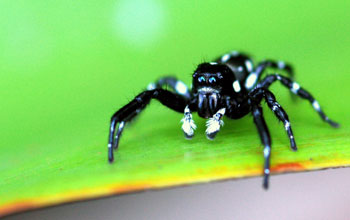Multimedia Gallery
CEIBA Research, Guyana (Image 4)
Black and white jumping spider (Phidippus audax). Commonly found around homes and in gardens, the black and white jumping spider (Phidippus audax) hunts in the daytime. Young, immature spiders are black with reddish legs and three reddish-orange spots that will turn white when the spider matures. Adults can reach one-half inch in length and have large eyes on the front of their head. They get close to their prey before attacking, then jump on their victim.
The genus Phidippus are in the jumping spider family, and includes some of the largest jumping spiders. Many species are characterized by their brilliant, iridescent green chelicerae. Phidippus are distributed almost exclusively in the American continents and adjacent islands collectively, although four species are found in India and one in Bangladesh.
This image was taken as part of research centered at the CEIBA Biological Center, Inc. in Guyana, by Professor Godfrey Bourne of the department of biology at the University of Missouri-St. Louis. Bourne is currently program director of the Behavioral Systems Cluster, Division of Integrative Organismal Biology at the National Science Foundation.
Bourne is personally involved in administrating the CEIBA Biological Center Inc. as a nonprofit research, education and conservation field station in Guyana. Research opportunities for postdoctoral associates, graduate and undergraduate students are available in Guyana on a diversity of organisms.
This research was supported in part by the National Science Foundation. [One of several related images. See next image Here.] (Date of Image: 2004-2006)
Credit: Photo by Godfrey R. Bourne
See other images like this on your iPhone or iPad download NSF Science Zone on the Apple App Store.
Images and other media in the National Science Foundation Multimedia Gallery are available for use in print and electronic material by NSF employees, members of the media, university staff, teachers and the general public. All media in the gallery are intended for personal, educational and nonprofit/non-commercial use only.
Images credited to the National Science Foundation, a federal agency, are in the public domain. The images were created by employees of the United States Government as part of their official duties or prepared by contractors as "works for hire" for NSF. You may freely use NSF-credited images and, at your discretion, credit NSF with a "Courtesy: National Science Foundation" notation.
Additional information about general usage can be found in Conditions.
Also Available:
Download the high-resolution JPG version of the image. (930 KB)
Use your mouse to right-click (Mac users may need to Ctrl-click) the link above and choose the option that will save the file or target to your computer.

